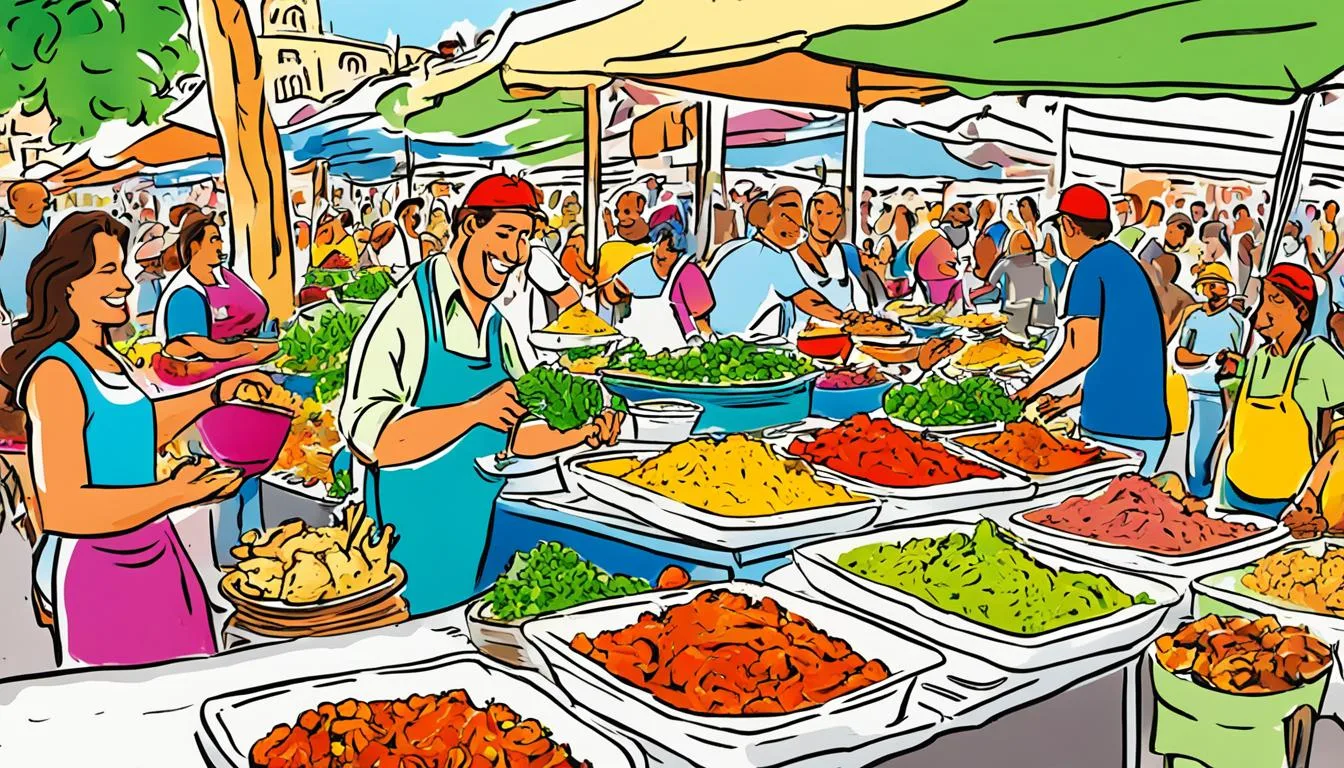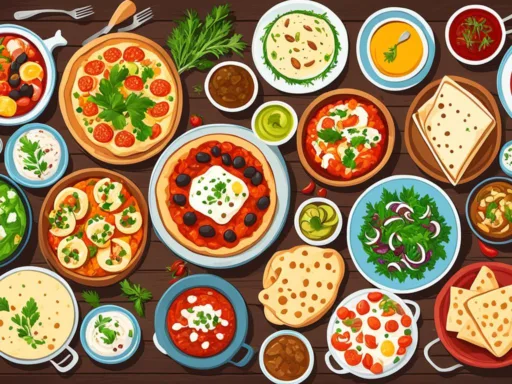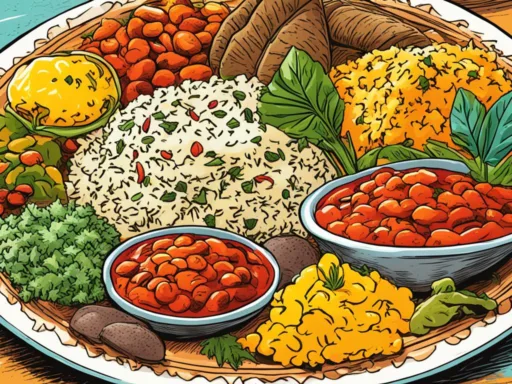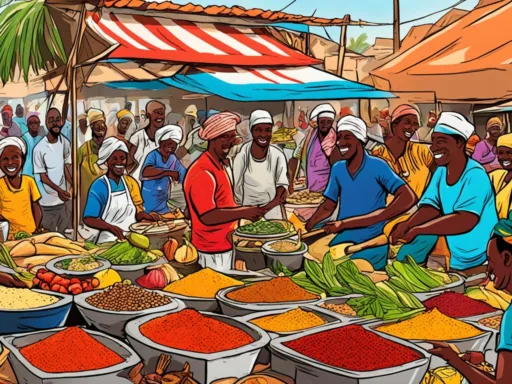In the heart of the Caribbean, a staggering 10% of the Dominican Republic’s GDP is served up from its sizzling kitchen stoves and abundant food markets. This fascinating statistic plates up just how pivotal the food industry is within this vibrant nation, feeding not only its economy but also the soul of its culture. Embarking on a Dominican Republic Culinary Tour is more than a simple taste-testing endeavor; it’s a full-bodied plunge into a sea of traditions and innovative gastronomy that make up the country’s rich heritage. From the tropical town squares dotted with food stalls to the sophisticated restaurants of Santo Domingo, a Caribbean cuisine exploration is a multifaceted experience of history, community, and of course, an elite flavor exploration trip for the epicurean adventurer.
Key Takeaways
- Discover the impact of the Dominican Republic’s gastronomy on its culture and economy.
- Experience a culinary journey reflecting the country’s rich history and diverse influences.
- Learn about the signature dishes that define a true Caribbean cuisine exploration.
- Understand the importance of local flavors in shaping an authentic flavor exploration trip.
- Gain insight into how traditional Dominican dishes contribute to the nation’s unique food narrative.
Dominican Republic Culinary Tour: A Melting Pot of Flavors
Embarking on a foodie adventure through the Dominican Republic offers a unique taste of its rich cultural history. The island’s gastronomy is a vibrant blend of indigenous Taíno, Spanish colonial, and African flavors—a true melting pot that satisfies the palate of even the most discerning epicureans. An authentic Dominican cooking journey is both an exploration and celebration of this fusion, creating a tapestry of tastes that are as colorful as the country’s heritage.
The Multicultural Origins of Dominican Cuisine
The culinary landscape of the Dominican Republic is a testament to its complex past. Each local dish provides insight into the island’s soul, having evolved from a confluence of various civilizations. Traditional Taíno ingredients have been artfully combined with the bold flavors brought by African slaves and the sophisticated culinary practices of Spanish colonizers, giving rise to a unique and inviting gastronomic experience.
Introducing the Iconic Dishes
Iconic Dominican dishes stand at the forefront of local dishes tasting, inviting gourmets to immerse themselves in a world of diverse palates. From hearty stews to zesty breakfasts, these dishes encapsulate the spirit of the island and offer a peek into its flavorful chronicles.
| Dish | Ingredients | Origin Influence |
|---|---|---|
| Sancocho | Seven types of meat, root vegetables, spices | African, Taíno, Spanish |
| Mangú | Boiled plantains, red onions, olive oil | Taíno |
| La Bandera | White rice, red beans, meat, fried plantains | Spanish, African |
| Tostones | Twice-fried plantains, salt, garlic | Taíno |
A tour through the bustling markets and quaint eateries of Santo Domingo reveals the essence of true Dominican flavors. Tasting these sumptuous plates is more than just a meal—it’s a journey through the stories and traditions of a nation.
From the bright and lively street food vendors to the elegant dining establishments, an authentic Dominican cooking journey guides you through a palette of tastes and textures, capturing the essence and evolution of Caribbean cuisine. Prepare to be delighted by each dish, a chapter of Dominican life, served on a platter for the world to taste.
Exploring the History Behind Dominican Gastronomy
The roots of Dominican gastronomy stretch deeply into a vibrant history, where the confluence of Taíno Indigenous staples and the layers added by European and African influences are profound. As we delve into the Santo Domingo gastronomy experience, each island culinary delight reveals a story of cultural syncretism and the survival of traditional practices through centuries of change.
The Taíno people, the island’s original inhabitants, provided the foundation with their use of native ingredients and simple yet effective methods of preparation. These practices did not vanish with the arrival of Europeans and Africans to the island in the 15th and 16th centuries; rather, they were adapted and enhanced. This resulted in dishes that carry the essence of Dominican history, infused with exotic flavors and bold techniques from distant lands.

The trading of sugar and rum in the 19th century brought yet another layer of complexity to the island’s cuisine, introducing new culinary techniques and ingredients that would continue to shape the nation’s palate. Today, their legacy can be tasted in the sweet undertones of various Dominican dishes and the prevalence of rum in local cooking.
Santo Domingo’s gastronomy experience is like a time capsule, with each dish representing a different era, from the subtle flavors of the Taíno to the robust African and Spanish contributions:
- Taíno influence is felt in the use of cassava and sweet potatoes.
- Spanish contributions are noted with the introduction of rice, wheat, and meats.
- African techniques shine through in the deep flavors and hearty stews.
Through this rich culinary journey, the past is made vibrant and the heritage of the Dominican people continues to be celebrated in every kitchen and every street corner where these island culinary delights are shared.
| Ingredient | Taíno Origin | European Addition | African Influence |
|---|---|---|---|
| Cassava (Yuca) | Staple food, basis for ‘Casabe’ | Preserved as a staple | Used in various stews and sides |
| Meats (Pork, Beef) | Game meats were common | Introduction of domesticated livestock | Creation of hearty and flavorful stews |
| Sweet Potatoes | Widely consumed, roasted or boiled | Continued use, incorporated in European dishes | Often used as a base in hearty dishes |
| Honey & Rum | Use of natural sweeteners like honey | Rum production began, adding a new flavor profile | Enriched desserts and marinades |
This blending of traditions and tastes not only defines the gastronomic tapestry of the Dominican Republic but also creates an experience that is a testament to the island’s history. To savor these dishes is to understand the pulse of the Dominican Republic: a rhythm set by the waves of history and the enduring spirit of its people.
The Aromatic Trail of Santo Domingo’s Gastronomy
Embarking on a flavor exploration trip through Santo Domingo unveils an intricate mosaic of tastes and aromas that hallmark the city’s streets and luxurious eateries. Authentic Caribbean cuisine exploration is the crux of this adventure, where every morsel whispers tales of tradition fused with innovative gastronomic artistry.
Journey Through Street Food: From Chimichurris to Tostones
The labyrinth of Santo Domingo’s bustling markets and vibrant alleyways is a paradise for street food aficionados. Here, culinary gems are served fresh and full of flavor, encapsulating the essence of Dominican culture.

Dishes like the iconic Chimichurri burger, a juicy meat patty seasoned with local herbs, and Tostones, twice-fried plantains with a perfect golden crust, are quintessential experiences for any traveler on a flavor exploration voyage. These palate-pleasers not only feed the stomach but also the soul, making a walk through Santo Domingo’s streets a dive into the heart of its culinary identity.
High-End Santo Domingo Eats
Contrasting the vibrant street food scene, Santo Domingo’s high-end restaurants offer a different, though equally enriching, facet of the city’s gastronomical tapestry. Here, traditional Dominican recipes are reimagined, marrying local ingredients with contemporary cooking techniques.
| Dish Type | Street Food Experience | High-End Dining Twist |
|---|---|---|
| Chimichurri Burger | Served in bustling markets, with a tangy salsa and crumble of queso fresco | Upgraded with gourmet beef cuts and artisanal buns, complemented by exotic sauces |
| Tostones | Enjoyed as a crunchy, savory snack from street vendors | Elevated with truffle oil and fine herbs in a stylish gastronomic setting |
The convergence of street savoir-faire with refined culinary art creates a flavor exploration trip vital to understanding the full spectrum of Caribbean cuisine exploration. As each restaurant aims to outdo the last in creativity, they collectively weave an ever-evolving narrative of Dominican flavor.
Caribbean Cuisine Exploration: Signature Dominican Dishes
A journey through the Dominican Republic’s culinary landscape is a feast of flavors waiting to be discovered. The island’s rich history and cultural diversity are reflected in every dish, offering a flavor exploration trip that tantalizes the taste buds and nourishes the soul. The local dishes tasting experience invites epicureans to immerse themselves in the essence of Caribbean cooking. Here, we delve into some of the most emblematic fares that comprise the island culinary delights.
The Indomitable ‘La Bandera Dominicana’
The ‘La Bandera Dominicana’ or simply ‘La Bandera’, is the cornerstone of Dominican lunchtime cuisine. This beloved dish triumphantly displays the colors of the Dominican flag: white rice symbolizes purity, red beans represent the blood shed by heroes, and meat, often chicken, beef, or pork, stands for the nation’s strength. This meal isn’t just sustenance; it’s a patriotic emblem of the Dominican Republic’s rich cultural heritage—a true representation of local dishes tasting.

Comfort in a Bowl: The Famous Sancocho
No Dominican gathering is complete without a heaping bowl of Sancocho. This hearty stew is a fusion of flavors, featuring an assortment of meats that often includes beef, pork, chicken, and even goat, mingling with a variety of tubers and vegetables. Every spoonful is an invitation to partake in a communal experience, a celebration of the island’s generous spirit, and an essential stop on any flavor exploration trip within the Dominican gastronomic panorama.
The gastronomic adventures in the Dominican Republic offer an exquisite tapestry of tastes and traditions that capture the island’s heart. To truly understand and appreciate this vibrant culture, one must delve into the local culinary delights, making food not just part of the journey but the destination itself.
Local Dishes Tasting: A Masterclass of Dominican Flavors
Embark on an authentic Dominican cooking journey and taste the island’s heritage in every bite. For the true foodie adventure, a tasting tour will unlock the secrets behind the Dominican Republic’s most beloved dishes. Here, the beauty of the cuisine is unveiled not just in its rich taste but in the stories each recipe tells – stories of simplicity, community, and history.
Central to this culinary masterclass lies the beloved dish Mofongo. Resonating with cultural history and crafted from the most unpretentious of ingredients, Mofongo is more than just food – it’s a legacy. Savored by locals and travelers alike, its traditional combination of flavors epitomizes the essence of Dominican culinary prowess.

Beyond Mofongo, the Dominican Republic’s marketplaces offer a cornucopia of ingredients just waiting to transform into delectable creations. Avail yourself of a venture into these vibrant realms of flavor and partake in a foodie adventure that leads to the heart of Dominican culture.
| Local Dish | Main Ingredients | Flavor Profile |
|---|---|---|
| Mofongo | Fried Plantains, Garlic, Pork Rinds | Earthy, Garlicky, Savory |
| La Bandera Dominicana | White Rice, Beans, Meat, and Salad | Hearty, Comforting, Balanced |
| Sancocho | Seven Types of Meats, Tubers, Vegetables | Robust, Deeply Satisfying, Spiced |
| Tostones | Twice-Fried Green Plantains | Crispy, Salty, Versatile |
Each dish, much like a carefully worded sentence in a narrative, adds depth to the unfolding story that is the authentic Dominican cooking journey. Culinary enthusiasts from far and wide are invited to indulge in this intimate, flavor-laden odyssey. Prepared to fall in love with each morsel, for this is a gastronomic endeavor that truly captures the soulful melody of the Dominican table.
The Art of Dominican Coastal Cuisine: Seafood Delights
Delving into the heart of island culinary delights, the coastal regions of the Dominican Republic offer an oceanic feast that entices seafood aficionados on a flavor exploration trip. As you journey along the picturesque shores, you’re greeted with dishes that not only tantalize the palate but also embody the spirit of the ocean.
Crunch and Savor: Fried Fish & Green Plantains
Imagine a plate filled with the day’s catch, fried to a perfect golden brown, and accompanied by slices of green plantains known locally as tostones. This is a pairing that unites the freshness of the sea with the earthy tones of the island’s beloved root vegetable, culminating in a symphony of crunch and flavor that is the essence of Dominican coastal gastronomy.
Grilled Octopus: A Dominican Twist on a Mediterranean Classic
With the gentle sea breeze in the air, the grilled octopus presents itself as a tender, smoky delight bursting with the zest of local spices. This dish represents an innovative island take on a Mediterranean favorite, and it’s a testament to how Dominican culinary practices can add a new dimension to a classic preparation.
Here’s a closer look at these scrumptious seafood offerings that represent the true taste of the Dominican Republic:
| Dish | Description | Key Ingredients |
|---|---|---|
| Fried Fish | Crispy exterior with moist, flaky interior | Fresh fish, lime, salt, garlic |
| Green Plantains (Tostones) | Twice-fried plantain slices with a savory crunch | Plantains, oil, salt |
| Grilled Octopus | Char-grilled to tender perfection with a Dominican twist | Octopus, local herbs, olive oil |
The Dominican connection to the sea is at the forefront with dishes that are as visually stunning as they are delectable. The synergy between fresh seafood and traditional cooking techniques highlights the simplicity and sophistication present in this rich culinary landscape.
Whether it’s the crunch of the fried fish that resonates with the sound of crashing waves or the succulent grilled octopus that pays homage to the fishermen’s daily haul, the edible treasures of the Caribbean Sea await those ready to set sail on this experiential voyage of taste in the Dominican Republic.
Flavor Exploration Trip: Dominican Street Foods You Can’t Miss
A true street food adventure in Santo Domingo is a rich tapestry of flavors, colors, and textures. Immerse yourself in the bustling energy of city markets and roadside stands where the heart of Santo Domingo gastronomy experience beats strongest. Here lies an authentic showcase of local culture, shaped over centuries and ready to be served up in a single bite.
The Chimi: A Dominican Take on Burgers
Stumble upon the numerous street carts and experience the ‘Chimi,’ an ingenious Dominican transformation of the classic burger. This flavorful sandwich packs a punch with seasoned ground meat, usually beef, topped with a garden of fresh cabbage, tomatoes, onions, and drenched in a special Dominican sauce, all ensconced within pillowy bread. Emphasizing a balance between zest and texture, the ‘Chimi’ is a staple you can’t afford to miss.
Casabe: An Ancient Tradition Still Alive
Take a step back in time with Casabe, the ancient flatbread that has been a part of the island’s cuisine since the Taíno people stood as its sole inhabitants. This yucca-derived bread, crisp and subtly nutty, provides a unique textural contrast to the assortment of spicy, savory morsels found in Dominican street fare. A testament to Santo Domingo’s culinary heritage, Casabe is not just food—it’s a slice of history.
Top Street Foods in Santo Domingo:
- Chimi (Dominican burger)
- Casabe (yucca flatbread)
- Tostones (fried plantains)
- Pica Pollo (Dominican fried chicken)
In the end, a gastronomical escapade through Santo Domingo’s streets offers more than a meal — it’s an edible narrative of the country’s past and present. Embarking on this unparalleled street food adventure is essential for any food lover seeking to savor the true essence of the Dominican gastronomy experience.
Island Culinary Delights: Sweets and Desserts of the DR
Immerse yourself in the sweeter side of the Dominican Republic, an essential finale in any Caribbean cuisine exploration. Here, the tradition of sugary delights not only satisfies the sweet tooth but also narrates a piece of the island’s history, interweaving generational recipes with cultural pride. Precious local dishes tasting moments are crafted with ingredients that evoke the Dominican spirit, expressing a legacy stitched with sugar, spice, and everything nice.
Embrace the Sweetness: Dulce de Coco and Tres Leches
Dulce de Coco, with its creamy texture and rich coconut flavor, beckons those with a penchant for tropical indulgence. On the other hand, the Tres Leches cake is a moist melody of milks, creating a dessert that’s beloved and ubiquitous during Dominican festivities. Let’s delve deeper into these classic desserts that capture the essence of Dominican confectionery mastery.
| Desert Name | Main Ingredients | Occasions Typically Served | Tasting Notes |
|---|---|---|---|
| Dulce de Coco | Coconut, milk, sugar, cinnamon | Holidays, family gatherings | Sweet, rich, with a hint of warm spice |
| Tres Leches Cake | Milk, cream, sugar, eggs, flour | Celebrations, birthdays | Lusciously moist, creamy, decadently sweet |
These confections are more than just a treat; they’re a true testament to the local dishes tasting experience that awaits in the Dominican Republic. Each bite is a revelation of the skills passed down through the ages, an homage to the sugar cane fields that once fueled the island’s economy, and a celebration of the vibrant culture that continues to thrive through its culinary craftsmanship.
Authentic Dominican Cooking Journey: Learn from the Masters
Embarking on a Dominican Republic Culinary Tour provides more than just the opportunity to taste the diverse palette of flavors the country has to offer; it also opens the door to a hands-on learning experience with the island’s esteemed chefs. These local maestros of gastronomy champion a Santo Domingo gastronomy experience that fuses time-honored recipes with contemporary cooking methods.
Notable figures, including Chef Tita, recognized internationally as the promoter of traditional Dominican flavors, imparts her knowledge and love for Caribbean cuisine to aspiring cooks and culinary enthusiasts. Chef Tita, with her bounty of wisdom, embodies the spirit of the Dominican kitchen. On the other hand, Chef Noemí Díaz at the vibrant ‘Jalao’ restaurant brings a dynamic twist to the foods of this tropical paradise, endearing themselves to both locals and travelers alike.
Dining at acclaimed venues such as Lago Restaurant within the luxurious confines of Casa de Campo, diners can delve into authentically crafted dishes that narrate the island’s history through every bite. It is a space where the complex layers of Dominican culinary heritage can be appreciated in their full glory.
- Classes with Chef Tita – Authentic techniques and ancestral recipes
- Experiences at Jalao – Combination of theatrical presentation and gastronomic delights
- Lago Restaurant – Exclusive immersion in high-end Dominican flavors
From the bustling food markets, bursting with fresh produce and staple seasonings, to the serene cocoa and coffee plantations, the Dominican Republic Culinary Tour provides a tapestry of experiences. Participating in cooking classes offers a hands-on approach to understanding the intricacies of Dominican flavors. It’s an invitation to roll up your sleeves, kindle a flame, and dance to the rhythm of pots and pans under the guidance of the island’s best chefs.
Each step in these experiences is an integral part of celebrating and comprehending the culinary wealth found in the heart of the Caribbean. It’s where food transcends being a mere sustenance but becomes a storyteller, an integral part of the cultural tapestry that is the Dominican Republic.
Conclusion
The journey through the Dominican Republic’s gastronomy is more than an excursion; it’s an immersive foodie adventure that narrates the story of its people and land. As the esteemed Culinary Capital of the Caribbean, the country continues to spread its tables with dishes that retain their authenticity while subtly blending in the nuances of contemporary tastes. This continuous culinary evolution is a passport to the past, present, and future tastes of the Dominican spirit, making every meal a page of history and every flavor a brushstroke of culture.
The Continuous Culinary Evolution of the Dominican Republic
Chefs and culinary artisans contribute to the dynamic tapestry of Dominican cuisine by innovating with traditional recipes, ensuring that each authentic Dominican cooking journey is rooted in rich traditions yet flashes hints of modern flair. This blend of the old with the new represents not just an adaptation of dishes but reflects the island’s indefatigable spirit to evolve and enchant with each serving. Today’s Dominican tables are a testament to this vibrancy, echoing the country’s commitment to gastronomic excellence.
Why a Culinary Journey in the DR is More Than Just Food
A culinary expedition in the Dominican Republic transcends the sensory pleasures of taste. It’s an embodiment of the island’s history, culture, and the communal essence that frames its identity. Each bite offers insight into the lifetime of a society, the resilience of a heritage, and the warmth of the Dominican welcome. Embarking on this journey is to weave oneself into the narrative of a people who pride not only in their savory masterpieces but in the shared joy that surrounds their creation and consumption. This is the heart of the Dominican culinary experience.






